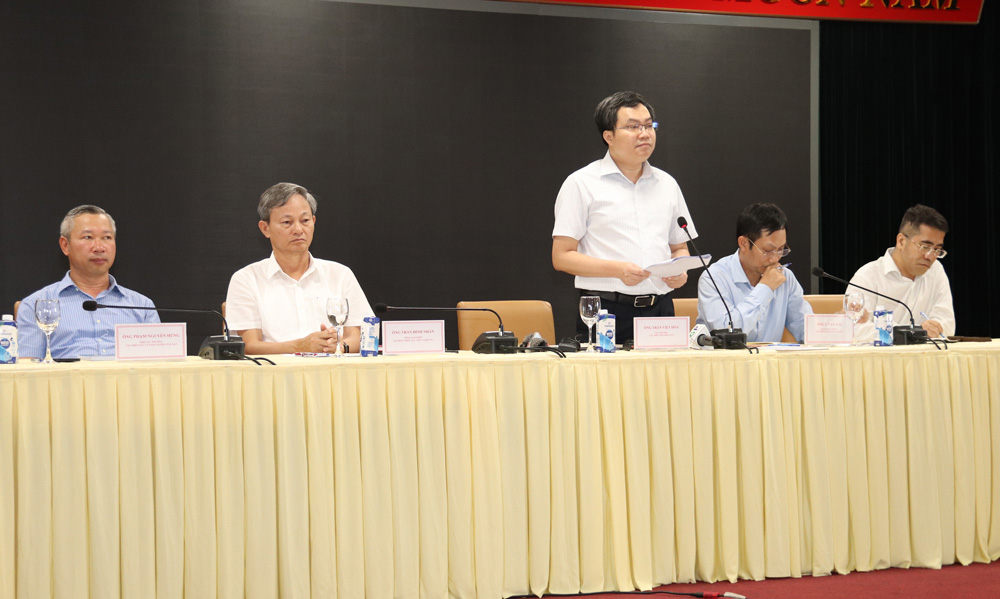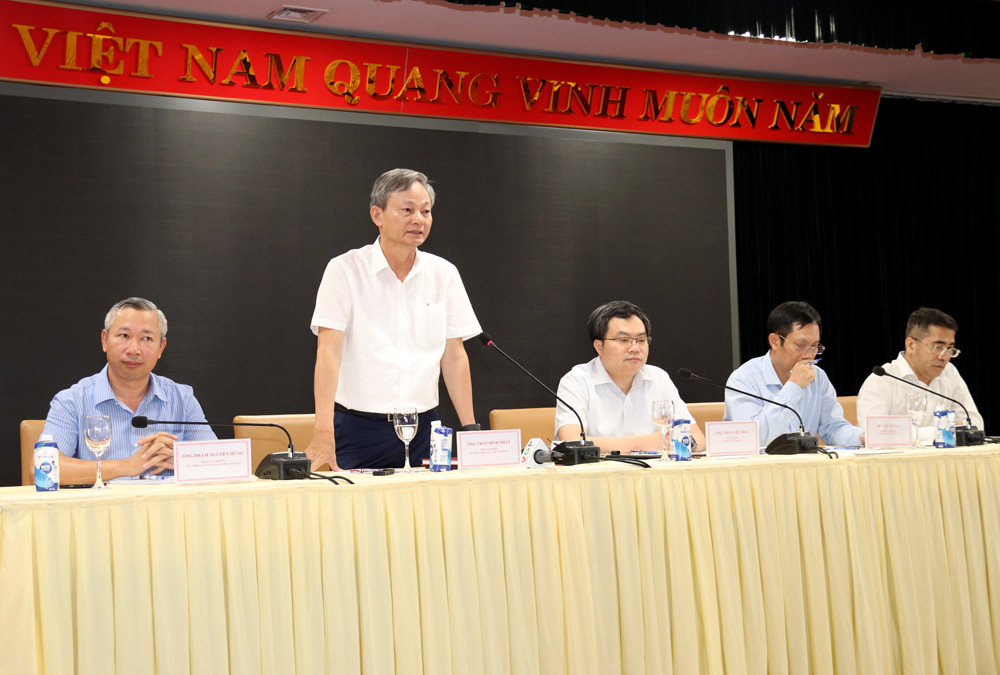On the afternoon of June 7, in Hanoi, MOIT held a press conference to provide information on the situation of the power supply in the hot season of 2023.
Extreme weather, more and more difficult
Mr. Tran Viet Hoa - Director of the Electricity Regulatory Authority (Ministry of Industry and Trade) said that the intense heat and the impact of the El Nino phenomenon taking place in many localities across the country have increased the people's demand for electricity use. Along with that, the low-level water condition of hydropower reservoirs has greatly affected the power supply in the dry season of 2023, especially in the North.
In the past time, under the close direction of the Government, although EVN, PVN, TKV, and relevant ministries and agencies have made efforts to implement many urgent solutions, up to now, there have appeared factors that negatively influenced the assurance of power supply, especially in the North.

Mr. Tran Viet Hoa - Director of Electricity Regulatory Authority shares at the press conference
According to Mr. Tran Viet Hoa, in the structure of power supply for the North, hydropower accounts for a large proportion (43.6%). However, as of June 6, 2023, most of the large hydropower reservoirs in the North have reached dead water levels, including Lai Chau, Son La, Tuyen Quang, Ban Chat, Hua Na, and Thac Ba. Particularly, the two hydropower reservoirs Lai Chau and Son La had to operate at least below the dead water level. Only the Hoa Binh hydropower plant can maintain its power generation until about June 12-13.
The total not mobilized capacity of hydropower sources in the North is at 5,000MW and can be up to 7,000MW when the Hoa Binh hydropower reservoir reaches the dead water level. Thus, as of June 6, 2023, the available capacity of hydropower is 3,110MW, only reaching 23.7% of the installed capacity.
Regarding thermopower, with the efforts made by relevant units, the supply of coal for power plants over time has been ensured. Plants have been operating with a high mobilization capacity. However, due to the hot weather, and high temperature, the units operate at maximum capacity for a long time, leading to equipment problems. In addition, many coal-fired power plants suffered from long-term problems (Vung Ang: 1 group, Pha Lai: 1 group, Cam Pha: 1 group, Nghi Son 2: 1 group). Typically, on June 1, the total capacity that could not be mobilized from coal-fired power plants in the North due to breakdowns and capacity decline was up to 1,030MW. By June 6, 2023, the coal-fired power source in the North only mobilized 11,934MW, about 76.6% of the installed capacity.
Meanwhile, the capacity to transmit power from the Central to the North via the North-Central 500kV transmission line is always at a high limit (maximum limit from 2,500MW to 2,700MW) leading to potential risk of breakdown.
According to Mr. Tran Viet Hoa, the total available capacity of the Northern power system (including imported electricity) that can be mobilized to meet the demand for power load is only 17,500-17,900MW (about 59.2% of the installed capacity). Meanwhile, the demand for electricity in the North may reach 23,500-24,000MW in the coming hot days. Thus, the electricity system in the North will be in shortage of about 4,350MW with an average daily output of approximately 30.9 million kWh (the highest day can reach 50.8 million kWh). The system faces the risk of lacking capacity at most hours of the day.
Expecting the understanding and sharing by customers
Currently, in order to ensure the safe operation of the power system, according to the provisions of law, specifically Circular No. 34/2011/TT-BCT dated September 7, 2011 (regulations on the formulation and implementation of power supply plans when the national power system lacks power sources), the National Load Dispatch Center (NLDC) has allocated the power saving capacity to the Hanoi Power Corporation and the Northern Power Corporation. Based on the allocated capacity, the two Power Corporations and their member companies also worked with the People's Committees of the provinces and cities to report on the power supply situation in the localities. Power companies have also allocated power-saving capacity to localities, in which priority is given to supplying power to key and essential customers following the regulations and characteristics of each locality.

Mr. Tran Dinh Nhan - General Director of EVN expects that business customers and people will sympathize and share with the current difficult situation.
Mr. Tran Dinh Nhan - General Director of EVN said that from mid-April until now, EVN has faced many difficulties in ensuring its power supply. The Group reported and was closely and promptly directed by the Prime Minister, Deputy Prime Minister, and leaders of MOIT. Following the direction of leaders at all levels, EVN has synchronously implemented solutions and mobilized all resources in ensuring power supply. Up to now, the central and southern regions have ensured power supply; the North is still facing many difficulties. EVN will try its best to maintain the safe operation of the national power system. However, as the demand for consumption continued to increase, the power supply was not enough, so at some time, it had to reduce power supply. EVN wishes business customers and people to sympathize and share this very difficult situation.
EVN, TKV, and PVN have been focusing all their resources on maintaining the availability of thermopower plants/units, speeding up the troubleshooting time as promptly as possible.
EVN also strives to operate the electricity system reasonably, try to increase the mobilization of thermopower to prevent the decline of hydropower water level; increase the water level of large hydroelectric reservoirs to higher the dead water level; proactively develop flexible scenarios to cope with difficulties in power supply in order to minimize impacts to people and businesses.
MOIT and EVN shall also create maximum conditions in negotiating electricity prices and power purchase agreements for transitional renewable energy projects to soon put these projects into operation. To date, 18 transitional renewable energy plants with a capacity of 1,115.62 MW have been mobilized (including plants in trial and commercial operation). The status of the implementation of documents and procedures for transitional renewable energy projects is continuously updated in a public and transparent manner by EVN via the website evn.com.vn and Fanpage of Vietnam Electricity.
At the same time, MOIT and EVN have also highly focused on effectively implementing solutions to enhance electricity saving. By the end of May, 63/63 provinces and cities have issued guiding documents on saving electricity in their localities. Particularly, Vietnam Electricity has drastically implemented saving measures such as the headquarters of EVN and its member units in the northern provinces and cities did not use air conditioners when the outdoor temperature was below 35 degrees Celsius; Limiting the use of lights, making the most of natural light sources, etc.
General situation in many Asian countries
More information at the press conference, Mr. Tran Viet Hoa - Director of the Electricity Regulatory Authority said that not only in Vietnam, but many Asian countries are also short of electricity in the record heat. For example, India, Thailand, Bangladesh, and even China are actively cutting off power alternately or limiting power supply for production to ensure the supply source. As in Yunnan (China) - a province with hydropower accounting for 72% of the total capacity – the situation of hot and dry weather has led to a lack of power and shall apply the electricity distribution regime to the critical energy-using industrial production facilities as well as apply strict measures to control power consumption.
It is forecasted that Asia will witness record heat this year. The severe weather conditions will increase electricity demand, continuing to pressure the electricity industry in many countries.
evn.com.vn
Share